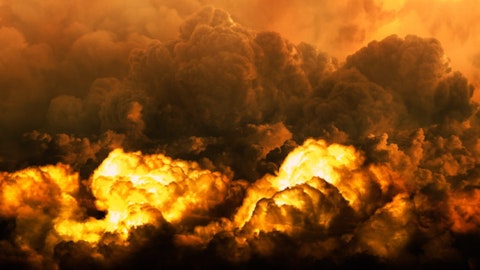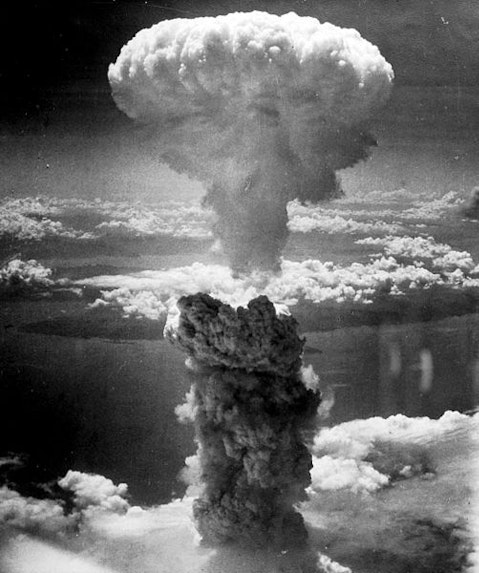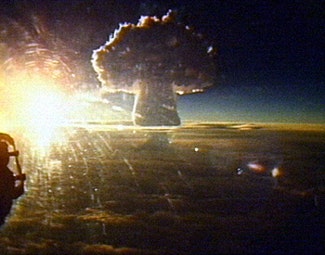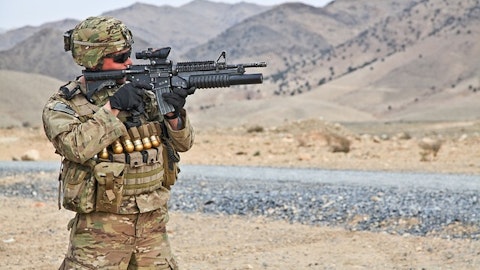Below you can find our list of the 5 most powerful weapons in the world. For a detailed discussion as well as a more comprehensive list please see 15 Most Powerful Weapons In The World.
5. FOAB
Aviation Thermobaric Bomb of Increased Power, nicknamed “Father of All Bombs” (FOAB) is a Russian-designed, bomber-delivered thermobaric weapon. It weighs 7,100 kilograms, and was dropped on the test range by the “Tu-160” strategic bomber. General Alexander Rukshin, Deputy Chief of Staff of the Russian Armed Forces, told that it is the strongest vacuum bomb in the world and that the results of tests of that weapon show that its efficiency and strength correspond to nuclear weapons, but that the use of these weapons does not pollute the environment. Thermobaric weapons are inhumane in the context of the fact that all those who would be in the zone of action of such a bomb would first suffocate, due to lack of oxygen, and then they would be crushed by the shock wave and burned at high temperatures. According to the assessment of the American edition of “National Interest”, the Russian bomb has a smaller mass, but it is still four times more powerful than the American MOAB. For example, the power of the explosion of the Russian FOAB is equal to the explosion of 40 tons of TNT, while the power of the American MOAB is equal to the explosion of ten tons of TNT. The Russian bomb has a radius of action 20 times larger than the American one.

4. B53 Nuclear bomb
The Mk/B53 was a high-yield bunker buster thermonuclear weapon developed by the United States during the Cold War with a yield of 9 megatons, which results in a fireball with an approximate 2.9 to 3.4 mi diameter and the radiated heat causes lethal burns to any unprotected person within a 20-mile radius. It was the most powerful weapon in the U.S. nuclear arsenal. This weapon is no longer used actively. Manufacturer of this bomb was The United States Atomic Energy Commission, commonly known as the AEC. That was an agency of the United States government established after World War II by U.S. Congress to foster and control the peacetime development of atomic science and technology.

3. LITTLE BOY AND FAT MAN
Little Boy was the code name for an atomic bomb dropped on the Japanese city of Hiroshima on August 6, 1945 from an Enola Gay plane (B-29 Super Fortress). The plane was flown by Colonel Paul Tibets of the 393rd Bomber Squadron of the United States Air Force. It was the first atomic bomb used as a weapon. It was dropped three days before the second bomb was dropped on Nagasaki. This bomb was developed as part of the Manhattan Project during World War II. Its explosive power comes from the nuclear fission of uranium 235. The bombing of Hiroshima was the second artificially induced nuclear explosion in history (the first was the Trinity test), as well as the first uranium-based detonation. Approximately 600 milligrams of mass is converted into energy. The bomb exploded at an altitude of about 600 meters and developed a destructive force equivalent to between 13 and 18 kilotons of TNT (estimates vary) and killed approximately 220,000 people. Its design has not been previously tested due to the fact that enriched uranium was very rare at that time, so the United States saved it.
Fat Man is the code name for an atomic bomb that detonated over Nagasaki, Japan, on August 9, 1945. The bomb was dropped by the United States. It was an implosion-type bomb, with a plutonium center. The fat man may have been named after Winston Churchill, although Robert Serber stated in his memoirs that as the bomb was round and thick, he named it after Casper Gutman from Sidney Green Street’s Maltese Falcon. Fat man’s design was similar to the design of the first atomic bomb device detonated during the Trinity atomic test. in July 1945. it was detonated at an altitude of approximately 550 m above the city, and was ejected from a B-29 bomber by a super fort. It was piloted by Major Charles Sweeney of the 393rd Bomber Squadron. The bomb had a power of approximately 21 kilotons of TNT, or 8.78 × 1013 joules = 88 TJ (terajoules). Since Nagasaki is on a hilly terrain, the damage from the explosion was somewhat less than in relatively flat Hiroshima. It is estimated that 39,000 people were killed and 25,000 injured in the bombing of Nagasaki. Thousands more later died from injuries caused by the explosion and burns, and hundreds more from radiation poisoning from exposure to the bomb’s initial radiation.

They were both designed by The Los Alamos Laboratory, also known as Project Y, a secret laboratory established by the Manhattan Project and operated by the University of California.
2. CASTLE BRAVO
Castle Bravo was an operation during which the U.S. tested a thermonuclear hydrogen bomb for the first time. The test was performed on March 1, 1954 at Bikini Atoll in the Marshall Islands. The direct result of the explosion was nuclear rain, which poisoned the islanders who returned to the island after the detonation. Members of the crew of the Japanese fishing boat Lucky Dragon No. were also poisoned, which raised the international question of the safety of conducting nuclear tests. The bomb used lithium-deuterium fuel for the nuclear reaction as well as cryogenic, deuterium-tritium liquid, which was used as the fuel for the nuclear reaction. The Ivy Mike bomb, which was the 16th nuclear bomb, represented the first test of the hydrogen bomb of the U.S. Armed Forces. Castle Bravo had the best result of all U.S. Army nuclear testing, 15MT, although again a significant proportion came from uranium fission. In the Teller-Ulam model, the fission and fusion phases occur physically separately. Castle Bravo was the most powerful American nuclear bomb ever detonated by the United States. With a power of 15 megatons, it greatly exceeded the projected power of 4-6 megatons. Combined with other factors, it was the most signified radiological device in U.S. history. Measured in kilotons, Castle Bravo was 1,200 times more powerful than the bomb dropped on Hiroshima and Nagasaki during World War II.

1. TSAR BOMB
Tsar bomb (Russian: Царь-бомба) is a nickname for the RDS-220 hydrogen bomb (codenamed Ivan, after its constructor). It is the most powerful nuclear weapon ever detonated. Made by the USSR, the bomb was initially supposed to have a power of 100 megatons of TNT, but due to the excessive risk of radiation and the spread of reactive particles through the atmosphere, the power was halved. Two bombs were built, one real and one copy. Test The bomb was tested on October 30, 1961 at exactly 11:32 local time in the Nova Zemlja archipelago. The bomb weighed 27 tons, was 8 m long, and had a circumference of 2 m. It was so big that it could not fit in the largest bomber of that time, which is why certain changes were made to the bomber. The bomb was dropped from a height of about 10.5 km and detonated 4 km above the ground. The fireball that formed at that time was 8 km wide, and the mushroom formed after the explosion was 65 km high, and about 40 km wide at the bottom. The area with a diameter of 35 km around the bomb was completely destroyed. It never entered military service and was only a demonstration of Soviet power and technology at the time.
Please also see 10 Most Powerful Militaries in the World in 2020 and 7 Most Powerful Navies in the World


